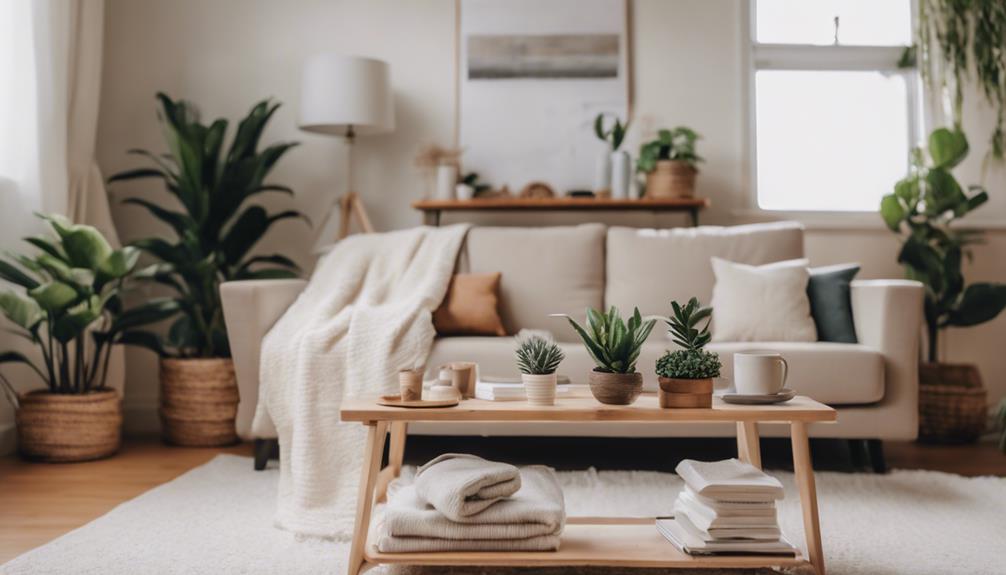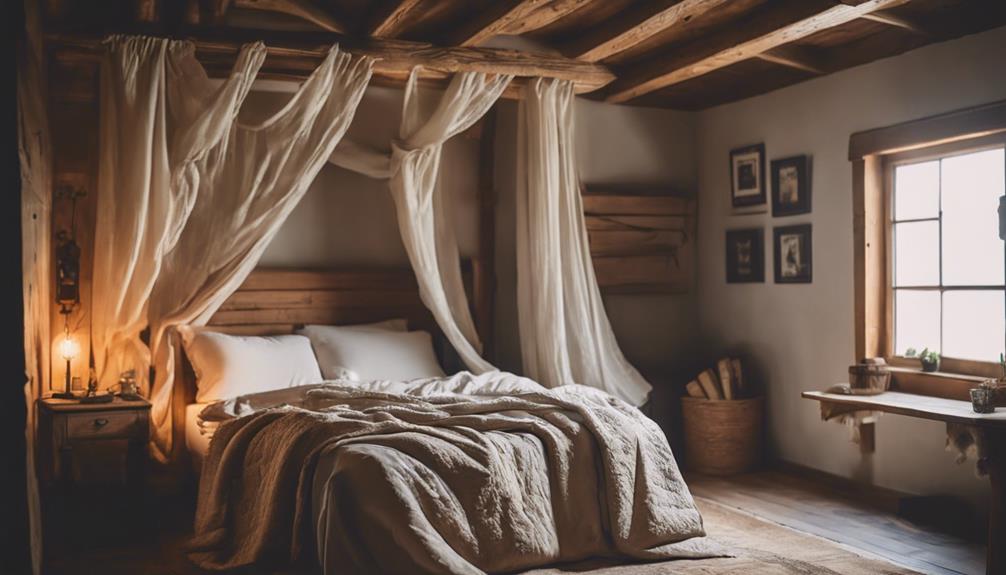To increase your earnings when selling your home decor, start by assessing your current inventory. Identify items that no longer align with your taste. Research market trends and pricing to optimize your profits. Prior to listing, clean and repair your pieces. Select the ideal platform for selling your decor. Craft compelling listings that highlight your products. Prepare to negotiate with potential buyers. Organize your display to make your decor truly shine. Handle shipping with care to ensure secure deliveries. Boost your profits by setting competitive prices. There is always more to discover about effectively selling your home decor and decluttering your space.
Key Takeaways
- Assess home decor inventory for items to sell.
- Research market trends and pricing.
- Prepare items by cleaning and repairing.
- Choose the right selling platform for your items.
- Set competitive prices based on market research.
Assessing Your Home Decor Inventory
When decluttering, start by evaluating your home decor inventory to determine what items you no longer need or use. Take a walk through your home and pay attention to the decorations on your walls, shelves, and tables. Look for pieces that no longer fit your style or serve a purpose. It's easy to overlook items that have become part of the background, so be intentional in your assessment.
As you go through each room, ask yourself if each decor piece brings you joy or adds value to the space. Consider setting aside items that you feel indifferent about or that no longer align with your aesthetic preferences.
Researching Market Trends and Prices

When selling home decor items, researching market trends and prices is essential.
You can analyze market prices, explore different trend research methods, and gather pricing strategy tips to maximize your sales potential.
Market Price Analysis
To effectively gauge market trends and prices in the home decor industry, begin by conducting thorough research on current selling prices and consumer preferences. Look into online marketplaces, such as Etsy, Wayfair, or Amazon, to see what similar items are selling for. Pay attention to the pricing strategies of successful sellers and identify trends in pricing based on factors like material, style, and brand.
Additionally, visit physical stores or attend local craft fairs to observe firsthand what types of home decor items are popular and at what price points they're being sold.
Take note of any unique or niche items that could potentially fetch a higher price due to limited availability or craftsmanship.
Trend Research Methods
Researching market trends and prices in the home decor industry involves analyzing current selling prices and consumer preferences to stay informed and competitive in your selling strategies. To start, visit online marketplaces, specialty home decor stores, and social media platforms to observe popular styles, colors, and materials. Take note of the pricing ranges for different types of items like wall art, furniture, or decorative accents.
Additionally, follow influential home decor bloggers, designers, and magazines to understand upcoming trends and customer demands. Utilize tools like Google Trends, Pinterest Trends, and industry reports to gather data on what's hot and what's not in the home decor market. Look for patterns in consumer behavior, such as a preference for sustainable materials or a shift towards minimalist designs.
Pricing Strategy Tips
Start by analyzing current selling prices and consumer preferences to develop an effective pricing strategy for your home decor products. Research market trends to understand what similar items are selling for and how they're priced. Look at both online platforms and physical stores to get a thorough view of the market. Pay attention to customer reviews and feedback to gauge what price points are attractive to buyers.
Consider the quality of your products when setting prices. High-quality items can often warrant higher prices, while lower quality may need to be priced more competitively. Factor in your production costs, including materials, labor, and overhead expenses, to secure you're pricing your products profitably.
Keep an eye on seasonal trends and adjust your pricing strategy accordingly. Some items may sell better at certain times of the year, allowing you to modify prices for maximum profit. By staying informed and flexible with your pricing, you can optimize your sales and attract more buyers to your home decor products.
Preparing Your Items for Sale
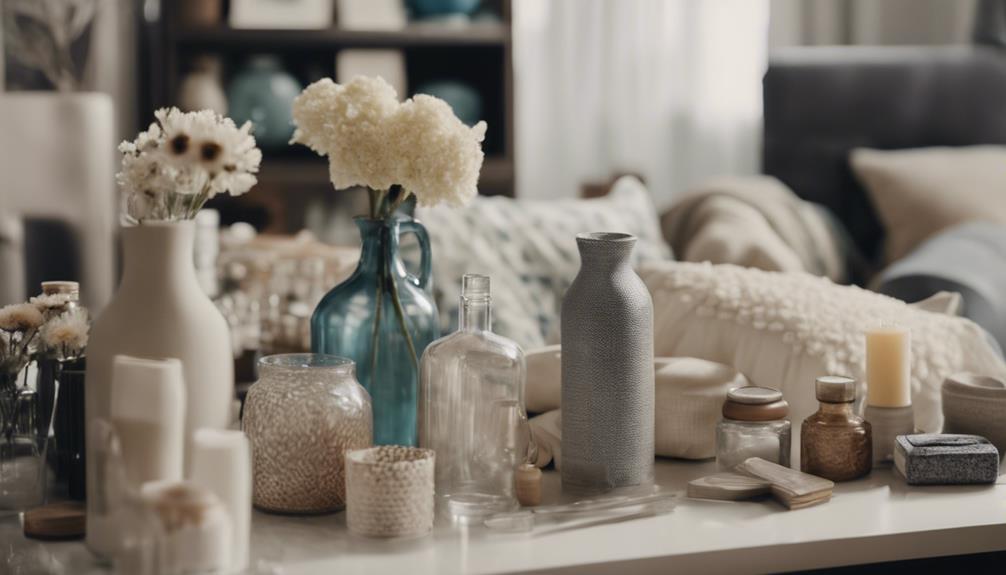
Make sure your home decor items are clean, well-maintained, and presentable before listing them for sale. Confirm each piece is free of dust, stains, or any damage that could deter potential buyers. A fresh appearance can notably increase the perceived value of your items.
To make your items stand out, consider the following tips:
| Tip | Description | Example |
|---|---|---|
| Clean Thoroughly | Give your items a deep clean to remove any dirt or grime. | Wipe down surfaces with a mild cleaner. |
| Repair Damage | Fix any minor damages such as loose screws, scratches, or chips. | Replace missing knobs or touch up paint. |
| Stage Well | Present your items in an appealing way to attract buyers. | Arrange your decor in an attractive display to showcase their potential. |
Choosing the Right Selling Platform

When selling your home decor items, it's important to think about the right platform. Online marketplaces like Etsy or Facebook Marketplace offer a wide reach, while local consignment shops provide a more personalized touch.
Take some time to explore these options to find the best fit for your items and selling style.
Online Marketplace Selection
Consider exploring different online marketplaces to determine the best platform for selling your home decor items and decluttering your living space effectively. Each online marketplace has its unique features and audience, so selecting the one that aligns best with your needs and target customers is crucial.
Start by checking out popular platforms like Etsy, eBay, Facebook Marketplace, and Chairish. Etsy is great for handmade or vintage items, while eBay offers a wide reach and auction-style selling. Facebook Marketplace allows you to sell locally and interact with potential buyers directly. Chairish caters to high-end furniture and decor pieces.
When deciding on a platform, consider factors such as listing fees, seller protections, shipping options, and audience demographics. Choose a platform that not only fits your items but also provides a user-friendly experience for both you and your potential buyers.
Researching and comparing different online marketplaces can help you maximize your profits and streamline the decluttering process.
Local Consignment Shops
Explore local consignment shops to find the ideal selling platform for your home decor items and decluttering efforts. Local consignment shops offer a convenient way to sell your gently used home decor pieces while supporting your community. By choosing a consignment shop, you can reach local buyers who appreciate unique finds and are willing to pay a fair price for quality items.
When selecting a consignment shop, consider the type of home decor items they specialize in and their target market. Look for shops that align with the style and quality of your pieces to increase the chances of a successful sale. Additionally, inquire about their commission rates and policies to guarantee they meet your expectations.
Visiting different consignment shops in your area allows you to compare their terms, display setups, and overall atmosphere. Building a relationship with the shop owners can also lead to future opportunities to sell more of your home decor items.
Take the time to research and visit local consignment shops to find the right fit for your selling needs.
Creating Compelling Product Listings
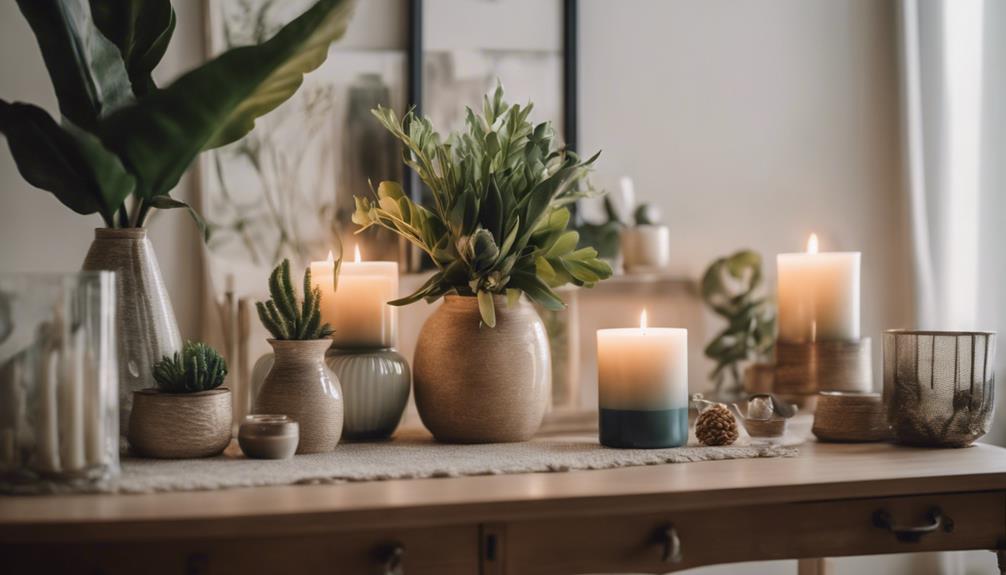
Craft engaging product descriptions that showcase the distinctive features and advantages of your home decor items to attract potential buyers. Start by highlighting the unique design elements, such as intricate hand-carved details or vibrant color schemes. Describe how these features can enhance the ambiance of a room, creating a cozy or luxurious atmosphere. Include specific dimensions and materials used to give buyers a clear idea of what to expect.
Use persuasive language to emphasize the benefits of each item. For example, mention how a stylish wall mirror can make a small space appear larger or how a set of decorative throw pillows can instantly refresh a sofa. Appeal to buyers' emotions by describing how a piece of art can evoke feelings of serenity or joy in a living space.
Incorporate keywords that potential buyers might use when searching for home decor online. Think about phrases like 'modern farmhouse wall art' or 'bohemian chic rug' that could help your listings appear in relevant search results.
Setting Competitive Prices

When setting prices for your home decor items, keep in mind the market demand and your competitors' pricing strategies.
Conduct a comparative analysis to see how your products stack up against similar ones in terms of quality and pricing.
Make adjustments as needed to guarantee that your pricing reflects the value your decor items bring to potential buyers.
Pricing for Market
To guarantee your home decor items are competitively priced in the market, conduct thorough research on similar products to gauge the appropriate pricing range. Start by exploring online marketplaces, visiting local stores, and attending home decor fairs to get an idea of how much items similar to yours are being sold for. Consider factors like quality, brand reputation, and uniqueness when comparing prices.
—
| Item | Average Price | Your Price |
|---|---|---|
| Wall Art | $50 – $100 | $60 |
| Throw Pillows | $20 – $40 | $25 |
| Table Lamps | $30 – $70 | $45 |
| Vases | $15 – $30 | $20 |
—
Comparative Analysis
For setting competitive prices in the market, carefully analyze the pricing of comparable home decor items to guarantee your pricing strategy is competitive and attractive to potential buyers. Start by researching online marketplaces, local stores, and social media platforms to get an idea of the current pricing trends.
Consider the following when conducting a comparative analysis:
- Quality: Assess the quality of your home decor items compared to others in the market.
- Brand Recognition: Take into account the brand recognition of similar products and how it affects pricing.
- Unique Features: Highlight any unique features your items possess that differentiate them from the competition.
- Customer Demand: Evaluate the demand for similar items and adjust your pricing strategy accordingly.
Adjusting for Value
Conduct a thorough evaluation of the value proposition of your home decor items compared to competitors to establish a competitive pricing strategy. Start by researching similar items in the market to understand their pricing and how your pieces differentiate themselves. Take into account factors like quality, uniqueness, and brand recognition.
Once you have a good grasp of the market landscape, consider setting your prices strategically. If your items offer exceptional quality or design, you might price them at a premium. On the other hand, if you want to move inventory quickly, pricing slightly below competitors can attract more buyers.
Remember to factor in any costs you incurred, such as materials, labor, or shipping, to make sure you're not selling at a loss. Additionally, keep an eye on market trends and adjust your prices accordingly to stay competitive.
Navigating Negotiations With Buyers

When negotiating with buyers, keep in mind their preferences and budget constraints to reach a mutually beneficial agreement. Understanding what they're looking for and what they can afford will help you tailor your negotiation strategies effectively.
Here are some tips to help you navigate negotiations smoothly:
- Listen actively: Pay attention to what the buyer is saying to understand their needs and concerns better.
- Be flexible: Show willingness to compromise on certain aspects to meet the buyer halfway.
- Highlight the value: Emphasize the unique features or benefits of your home decor to justify your asking price.
- Stay patient: Negotiations can take time, so remain calm and composed throughout the process to secure a favorable deal for both parties.
Organizing and Streamlining Your Space
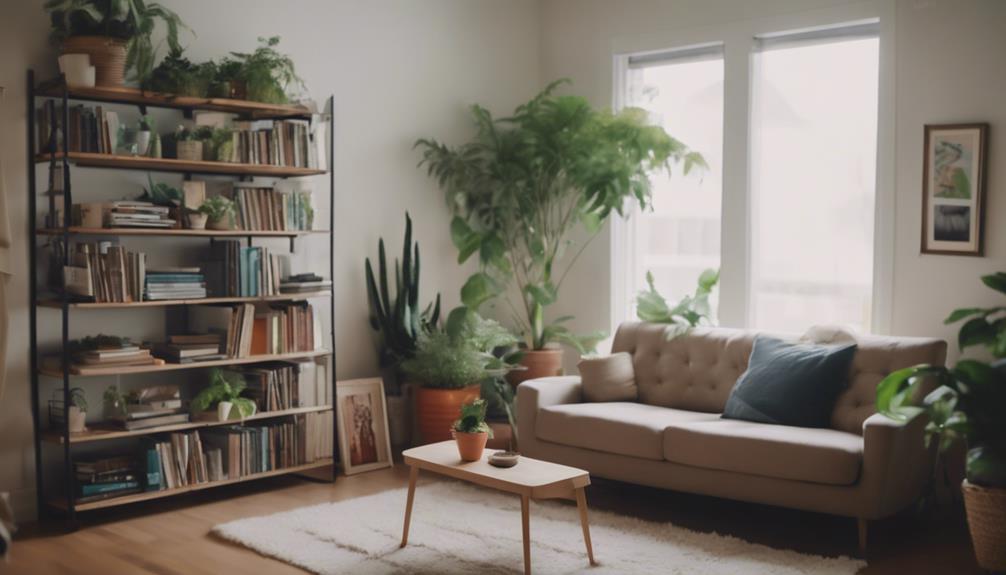
To create a more appealing space for potential buyers, start by decluttering and organizing your home decor effectively. Begin by removing any personal items like photographs or excessive knick-knacks. Clearing out clutter will make your space feel larger and allow potential buyers to envision themselves living in the space. Consider implementing storage solutions such as baskets, bins, or shelves to keep items organized and out of view.
Streamline your furniture layout to create an open and inviting atmosphere. Arrange furniture in a way that maximizes space and flow throughout the room. Remove any unnecessary furniture pieces that may overcrowd the space.
Additionally, consider neutralizing your color palette to appeal to a broader range of buyers. Fresh coats of paint in neutral tones can help create a clean and modern look.
Lastly, pay attention to lighting. Guarantee that each room is well-lit to showcase your decor effectively. Natural light is ideal, so open curtains and blinds to let light in. Add lamps or overhead lighting where needed to brighten up darker spaces.
Handling Shipping and Delivery Logistics

Consider utilizing a dependable shipping and delivery service to effectively manage the logistics of sending out your home decor items to customers. By entrusting this task to professionals, you can focus on growing your business and providing exceptional customer service.
Here are some tips to handle shipping and delivery logistics effectively:
- Choose a reputable shipping company: Look for a company with a track record of safe and punctual deliveries to guarantee customer satisfaction.
- Package items securely: Use appropriate packaging materials to safeguard your home decor pieces during transit and reduce the risk of damage.
- Track shipments: Keep tabs on your shipments using tracking numbers provided by the shipping company to monitor delivery status and address any potential issues promptly.
- Communicate with customers: Provide clear shipping information to your customers, including estimated delivery times and any relevant tracking details, to enhance their purchasing experience.
Maximizing Your Profit Margin
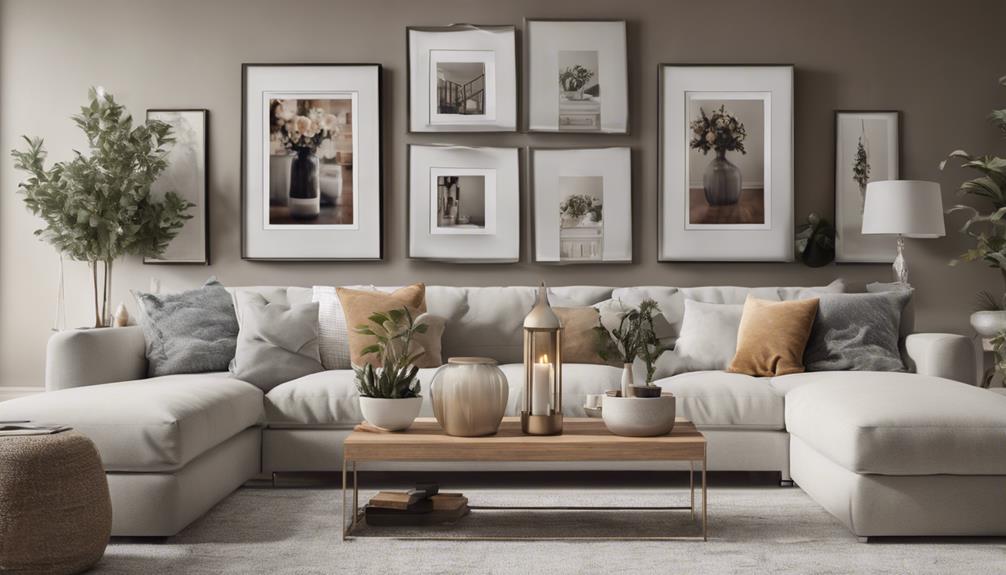
Boost your profit margin by implementing strategic pricing strategies and cost-saving measures without compromising on quality. Start by researching your competitors to set competitive prices while ensuring your products still offer value.
Consider offering discounts for bulk purchases or creating bundle deals to encourage customers to buy more. When pricing your items, factor in all costs, including materials, labor, and overhead expenses, to determine a fair yet profitable price point.
To save on costs, consider buying materials in bulk to secure discounts or sourcing them from wholesale suppliers. Additionally, optimize your production process to increase efficiency and reduce waste. Negotiate with shipping carriers to get the best rates and consider using eco-friendly packaging to appeal to environmentally conscious consumers.
Don't forget to analyze your sales data regularly to identify trends and adjust your pricing strategies accordingly. By being strategic with your pricing and finding ways to cut costs, you can maximize your profit margin and make your home decor business more lucrative.
Frequently Asked Questions
What Are the Best Ways to Attract Online Buyers to My Listings?
To attract online buyers to your listings, showcase high-quality photos, write compelling descriptions, offer competitive pricing, and provide excellent customer service. Utilize social media, online marketplaces, and targeted advertising to reach potential buyers effectively.
How Can I Safely Store and Protect My Decor Items During Sale?
When preparing to sell, safeguard your decor by using bubble wrap or storage bins to prevent damage. Protect valuable items in a secure location. Remember, 61% of buyers appreciate well-preserved items, increasing your chances of a successful sale.
Is It Better to Sell Items Individually or in Sets/Bundles?
When selling your decor items, it's generally more profitable to sell them individually rather than in sets or bundles. This way, you can showcase each piece's unique features and potentially attract a wider range of buyers.
How Do I Handle Returns or Refunds for Sold Decor Items?
When handling returns or refunds for sold decor items, be clear about your policy upfront. For instance, provide a 14-day return window for unused items with a receipt. Communicate professionally and promptly to resolve any issues.
Can I Sell Personalized or Custom-Made Decor Items Online?
Yes, you can sell personalized or custom-made decor items online. Consider setting clear customization options, pricing accordingly, and providing excellent customer service to guarantee satisfaction. Utilize platforms like Etsy or your own website for sales.
What are the most effective ways to sell home decor items for profit?
When it comes to how to sell home decor, the most effective ways include showcasing products in visually appealing displays, offering personalized customer service, and utilizing social media and online platforms to reach a wider audience. Additionally, attending home decor trade shows and collaborating with interior designers can also boost sales and profits.
Conclusion
To sum up, remember that one person's trash is another person's treasure! By following these steps and putting in the effort, you can turn your clutter into cash and make a tidy profit on your home decor items.
So don't delay, get started on decluttering and selling today to maximize your profit margin and create a more organized living space.
Remember, fortune favors the bold!
